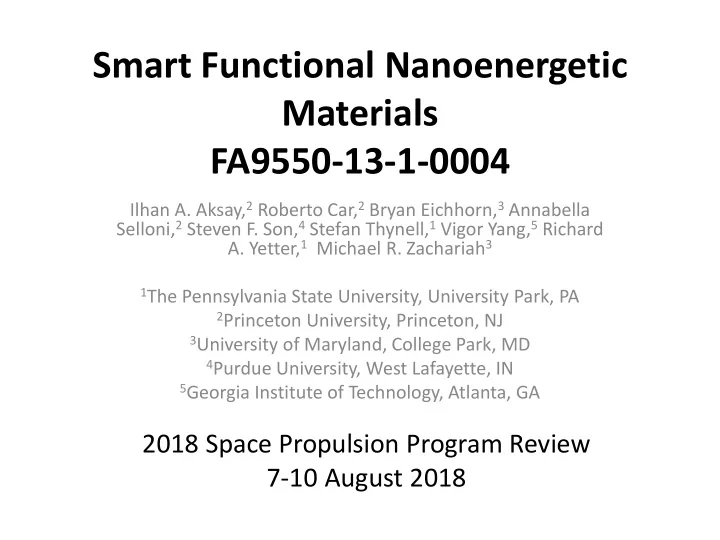

Smart Functional Nanoenergetic Materials FA9550-13-1-0004 Ilhan A. Aksay, 2 Roberto Car, 2 Bryan Eichhorn, 3 Annabella Selloni, 2 Steven F. Son, 4 Stefan Thynell, 1 Vigor Yang, 5 Richard A. Yetter, 1 Michael R. Zachariah 3 1 The Pennsylvania State University, University Park, PA 2 Princeton University, Princeton, NJ 3 University of Maryland, College Park, MD 4 Purdue University, West Lafayette, IN 5 Georgia Institute of Technology, Atlanta, GA 2018 Space Propulsion Program Review 7-10 August 2018
Our goal is to study hierarchically structured nanocomposite energetic materials as additives or replacements of fuel particles in current and future propellant formulations Specifically to: • Develop new macroscale (micron-sized or larger) energetic materials with nanoscale features that provide improved performance and ease of processing and handling, managed energy release, reduced sensitivity, and potential for internal/external control and actuation, and • Obtain fundamental understanding of the relationship between the integrated multi-length scale design and reactive and mechanical behaviors.
Breakthrough Discoveries • Assembled microparticles have significantly improved colloidal stability in hydrocarbon fuels. When formulated as an aluminum based thermite composite, these additives can enhance the burning rate of kerosene by up to 60% depending on the oxide used. • A heat conduction perspective to flame propagation in nanoenergetic materials was gained; methods for rational design of interfaces to control heat conduction rates have been identified. • The performance of Li-Al alloy based propellants have been characterized as a function of pressure. A start-up company from this work is testing motors with a variant of these propellants with promising results. Specifically, c* efficiency was 98.3% compared to 90.6% for Li-Al based propellant (ALITEC) and baseline aluminized propellant. ALITEC propellant produced a 33 seconds higher Isp at about 550 psi motor pressure. • Piezo-reactive materials were developed for control of energetic material sensitivity. A new paper was published this year. Thin films of PVDF-TrFE/nano aluminum were successfully poled to achieve a piezoelectric coefficient of 7 pC/N. • Reaction mechanisms for ammonia borane (AB) and hydroxylammonium nitrate (HAN) were validated showing the initiation of AB decomposition is from the reaction 2AB ⟷ BH 4 BH 2 NH 3 +NH 3 and a reduction of HNO 3 free energy by 2.5 kJ/mol (0.6kcal/mol) compared to the literature value. • Models and experiment show that well-dispersed graphene sheets within an imperfect polymer matrix compensate for mechanically weak areas in the polymer matrix when the sheets are covalently linked to each other, increasing composite strength and strain at failure. A threshold sheet concentration exists, above which strength and strain at failure decrease with increasing sheet content. • Conducting elastomers can be fashioned by incorporating functionalized graphene sheets into the matrix. A patent application for this process has been filed.
Potential Transitions • Adranos Energetics LLC, formed by Dr. Brandon Terry who worked on this project as a Ph.D. and Postdoc at Purdue, is developing technology discovered from the project. Patent application published Adranos research has developed a proprietary coating for Al-Li alloy and explored both propellant and enhanced blast material (DTRA SBIR project). Both show significant promise over conventional materials. References: (HTTPS://ENGINEERING.PURDUE.EDU/ZUCROW/NEWS/ADRANOS-ENERGETICS- FEATURED-ON-INSIDE-INDIANA-BUSINESS, HTTPS://WWW.YOUTUBE.COM/WATCH?V=QYAQAZSNHQA m/patent/US20180079697A1/en). • “Mechanically activated metal fuels for energetic material applications” TR Sippel, SF Son, LJ Groven US Patent 9,580,364 • “Conducting Elastomers” U.S. Patent Application 20170243670, I. A. Aksay and K. S. Sallah, Princeton University (August 24, 2017). Conducting elastomers formed through the incorporation of conductive carbonaceous materials, including carbon black and functionalized graphene sheets. These conducting elastomers combined with additive manufacturing of energetic materials allow for embedded sensors and controllable reactive particles.
Recommend
More recommend